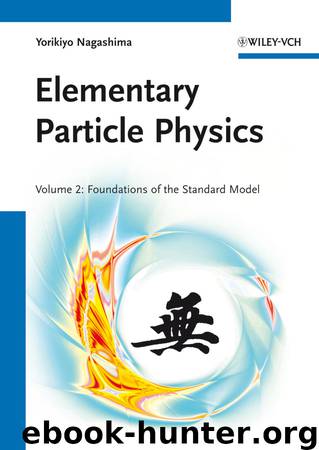Elementary Particle Physics by Nagashima Yorikiyo

Author:Nagashima, Yorikiyo [Nagashima, Yorikiyo]
Language: deu
Format: epub
Publisher: Wiley
Published: 2012-12-07T14:00:00+00:00
One should note that results of the above recipes vary, depending on processes. However, differences are generally not very large as is illustrated in Figure 7.6. The RGE at least guarantees that the residual error of calculations to is
Problem 7.6
Derive Eq. (7.93).
7.2.4 Running Mass
In deriving the RGE Eq. (7.61a), we ignored contributions of particle masses. This is satisfactory for light quarks (u, d and s), but not for the top quark. The charm and bottom quarks are marginal, depending on what one is dealing with. Therefore, we need to estimate the mass effect. Let us assume, for simplicity, that only one flavor of quarks has a nonnegligible mass. Since the mass term appears in the Lagrangian as it can be considered as an interaction to convert the left-handed fermions to the right-handed fermions or vice versa. Namely, the mass can also be considered as the varying coupling constant just like αs. It is apparent in the electroweak interaction because it is proportional to the strength of the coupling with the Higgs field. Besides, the mass is modified when higher order corrections are included and becomes a function of Q2 [see Eq. (5.28) and arguments in Volume 1, Sect. 8.1.6]. The scale factor μ comes in just like it does in the running coupling constant. Therefore, the mass effect can be treated in a similar manner as αs. Then, the RGE will take a form
(7.94a)
(7.94b)
It is possible to choose a renormalization scheme ( scheme included) in which the higher order correction is independent of (m/μ) [369]. Then, both β and γ are functions of αs (and μ2) only.
The solution can be found similarly to the running coupling constant, namely, by treating ln m and γs just like αs and μ. To solve the equation, we again define new variables (running mass) m(τ) defined by
(7.95a)
with boundary conditions
(7.95b)
We also write m(0) = m(μ2) because τ = 0 means Q2 = μ2. The solution is obtained as
(7.96)
The second equation follows from Eq. (7.65). In terms of the running coupling constant and running mass, the solution of the renormalization group equation takes a similar form as before. It is given by folding all the μ2 dependence in αs (τ) and m(τ), namely, it is given by
(7.97)
Problem 7.7
Show that Eq. (7.97) satisfies Eq. (7.94).
Download
This site does not store any files on its server. We only index and link to content provided by other sites. Please contact the content providers to delete copyright contents if any and email us, we'll remove relevant links or contents immediately.
| Atomic & Nuclear Physics | Particle Physics |
The Complete Stick Figure Physics Tutorials by Allen Sarah(7310)
Secrets of Antigravity Propulsion: Tesla, UFOs, and Classified Aerospace Technology by Ph.D. Paul A. Laviolette(5310)
Thing Explainer by Randall Munroe(3877)
The River of Consciousness by Oliver Sacks(3542)
The Order of Time by Carlo Rovelli(3145)
How To by Randall Munroe(3036)
A Brief History of Time by Stephen Hawking(2962)
I Live in the Future & Here's How It Works by Nick Bilton(2938)
The Great Unknown by Marcus du Sautoy(2648)
What If?: Serious Scientific Answers to Absurd Hypothetical Questions by Randall Munroe(2637)
Midnight in Chernobyl by Adam Higginbotham(2483)
Blockchain: Ultimate Step By Step Guide To Understanding Blockchain Technology, Bitcoin Creation, and the future of Money (Novice to Expert) by Keizer Söze(2450)
Networks: An Introduction by Newman Mark(2360)
The Meaning of it All by Richard Feynman(2300)
Easy Electronics by Charles Platt(2282)
The Tao of Physics by Fritjof Capra(2231)
Midnight in Chernobyl: The Untold Story of the World's Greatest Nuclear Disaster by Adam Higginbotham(2177)
When by Daniel H Pink(2083)
Introducing Relativity by Bruce Bassett(2080)
